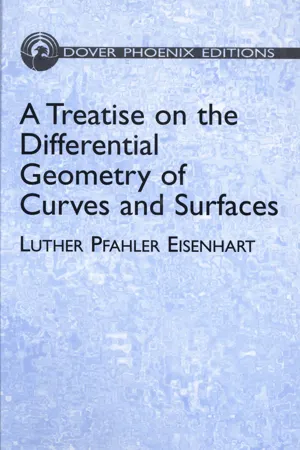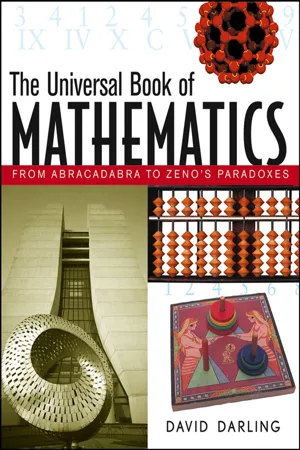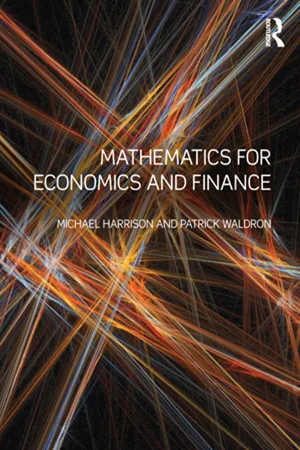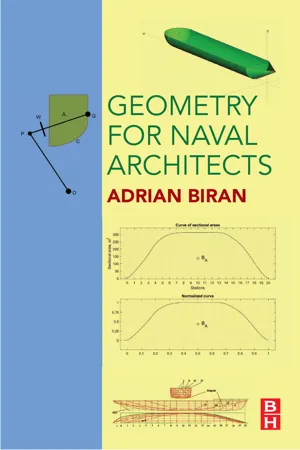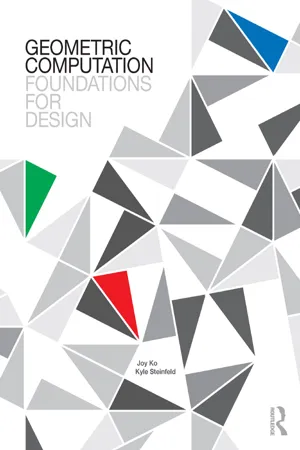Mathematics
Parametric Hyperbolas
Parametric hyperbolas are a type of hyperbola that can be defined using parametric equations. These equations involve using a parameter to represent the x and y coordinates of points on the hyperbola. By varying the parameter, different points on the hyperbola can be generated, allowing for a more flexible and versatile way to describe the curve.
Written by Perlego with AI-assistance
Related key terms
Related key terms
1 of 4
Related key terms
1 of 3
5 Key excerpts on "Parametric Hyperbolas"
- Luther Pfahler Eisenhart(Author)
- 2013(Publication Date)
- Dover Publications(Publisher)
CHAPTER ICURVES IN SPACE
1. Parametric equations of a curve . Consider space referred to fixed rectangular axes, and let (x, y, z ) denote as usual the coördinates of a point with respect to these axes. In the plane z = 0 draw a circle of radius r and center (a, b). The coördinates of a point P on the circle can be expressed in the form(1)where u denotes the angle which the radius to P makes with the positive x -axis. As u varies from 0° to 360°, the point P describes the circle. The quantities a, b, r determine the position and size of the circle; whereas u determines the position of a point upon it. In this sense it is a variable or parameter for the circle. And equations (1) are called parametric equations of the circle.FIG. 1A straight line in space is determined by a point on it, P 0 (a, b, c), and its direction-cosines α, β, γ. The latter fix also the sense of the line. Let P be another point on the line, and let the distance P 0 P be denoted by u, which is positive or negative. The rectangular coördinates of P are then expressible in the form(2)To each value of u there corresponds a point on the line, and the coördinates of any point on the line are expressible as in (2). These equations are consequently parametric equations of the straight line.When, as in fig. 1 , a line segment PD, of constant length a, perpendicular to a line OZ at D, revolves uniformly about OZ as axis, and at the same time D moves along it with uniform velocity, the locus of P is called a circular helix. If the line OZ be taken for the z- axis, the initial position of PD for the positive x- axis, and the angle between the latter and a subsequent position of PD be denoted by u, the equations of the helix can be written in the parametric form(3)where the constant b is determined by the velocity of rotation of PD and of translation of D. Thus, as the line PD describes a radian, D moves the distance b along OZ.In all of the above equations u is the variable or parameter. Hence, with reference to the locus under consideration, the coördinates are functions of u- eBook - ePub
The Universal Book of Mathematics
From Abracadabra to Zeno's Paradoxes
- David Darling(Author)
- 2008(Publication Date)
- Trade Paper Press(Publisher)
e = 1) is the limiting case of both the ellipse and the hyperbola.A hyperbola has two asymptote s: the never-quite-attainable limits of the curve’s branches as they run away to infinity. The transverse axis of the hyperbola is the line on which both foci lie and that also intersects both vertices (turning points); the conjugate axis goes through the center and is perpendicular to the transverse axis.hyperbola© Jan Wassenaar, www.2dcurves.comA rectangular hyperbola has an eccentricity of , asymptotes that are mutually perpendicular, and the property that when stretched along one or both of its asymptotes remains unchanged. This special case of the hyperbola was first studied by Menaechmus . Euclid and Aristaeus wrote about the general hyperbola but only studied one branch of it, while Apollonius was the first to study the two branches of the curve of the hyperbola and is generally thought to have given it its present name.The pedal curve of a hyperbola with one focus as the pedal point is a circle. The pedal of a rectangular hyperbola with its center as pedal point is a lemniscate of Bernoulli . The evolute of a hyperbola is a Lamé curve . If the center of a rectangular hyperbola is taken as the center of inversion, the rectangular hyperbola inverts to a lemniscate. If the vertex is used as the center of inversion, the rectangular hyperbola inverts to a right strophoid . If the focus of a hyperbola is taken as the center of inversion, the hyperbola inverts to a limaçon (see limaçon of Pascal ). In this last case if the asymptotes of the hyperbola make an angle of π/3 with the axis that cuts the hyperbola, then it inverts to the Maclaurin trisectrix . See also hyperboloid .hyperbolic geometry
One of the two main types of non-Euclidean geometry and the first to be discovered. It is concerned with saddle-surfaces, which have negative curvature and on which the geodesic s are hyperbolas . In hyperbolic geometry, contrary to the parallel postulate , there exists a line m and a point p not on m such that at least two distinct lines parallel to m pass through p . As a result, the sum of the angles of a triangle is less than 180° and, for a right triangle, the square of the hypotenuse is greater than the sum of the squares of the other two sides. See also elliptical geometry - eBook - ePub
- Michael Harrison, Patrick Waldron(Authors)
- 2011(Publication Date)
- Routledge(Publisher)
b also come together, so that the equation of the ellipse converges toWe have seen that both hyperbola and ellipse collapse onto the horizontal axis as ϵ approaches unity; the parabola, which arises when ϵ = 1, is a singularity or discontinuity in this process.(4.17) which is the familiar equation of a circle of radius a centred at the origin. Thus the circle can be viewed as the conic section with eccentricity zero.x 2+y 2=a 2At the other extreme, as the eccentricity of a hyperbola tends to infinity, b also approaches infinity, and the term in y vanishes from the equation, leaving the pair of parallel vertical lines with equation x2 = a2 or x = ±a.The shape of a conic section also changes qualitatively as the focus parameter a approaches zero. The parabola collapses onto the positive x axis and the ellipse collapses onto the origin. The hyperbola, however, converges to the pair of lines that are its asymptotes. The details are left as Exercises 4.1 and 4.2.4.2.5 General quadratic equation in two variables
In the coordinate plane, the graph of a quadratic equation in two variables x and y is always a conic section, and all conic sections arise in this way. The equation will be of the formA(4.18) with A, B and C not all zero. The equation also relates to the concept of matrix quadratic form, introduced in the following section.x 2+ B x y + Cy 2+ D x + E y + F = 04.3 Quadratic forms
Definition 4.3.1 A quadratic form inxis a matrix product of the form x┬ Ax, where x ≠ 0.n × 1Clearly A is of order n × n. Some texts require that A be symmetric, but this is not essential and sometimes using non-symmetric matrices is relevant. For present purposes, we also assume that A is a real symmetric matrix. It should also be noted that x┬ Ax is a scalar.Example 4.3.1 Supposex =,[]x 1x 2A =and a12 = a21[]a 11a 12a 21a 22 - eBook - ePub
- Adrian Biran(Author)
- 2018(Publication Date)
- Butterworth-Heinemann(Publisher)
Chapter 4Parametric Curves
Abstract
A curve can be represented by an implicit equation,f ( x , y ) = 0,f ( x , y , z ) = 0, by an explicit equation,y = f ( x ),z = f ( x , y ), or by parametric equations,x =,f 1( t )y =,f 2( t )z =f 3( t ) - eBook - ePub
- Joy Ko, Kyle Steinfeld(Authors)
- 2018(Publication Date)
- Routledge(Publisher)
Previous examples have demonstrated the wealth of mathematical curves available to us, and the often confounding relationship between parametric equations and the forms of curves they produce. Simple parameterizations can generate some of the most complex and beautiful forms (a cochleoid, for example), while it can take a maddeningly complex set of equations to produce visually simple forms.While the pure mathematical forms found in this exercise are unlikely to be applied unaltered in any design context, they are plausible starting points for the underlying logic of a nascent form. An understanding of these mathematical curves holds value beyond the forms they might represent, as we are sure to become more astute designers when we arm ourselves with a firm understanding of the relationship between code, equation, and form.Some Familiar Parameterizations
We have already encountered the standard parameterizations for a circle. Here, we build upon this understanding by looking at the related parameterizations for ellipses, helices, and spirals.Ellipses
An ellipse in the plane centered at the origin with semi-major axis a and semi-minor axis b can be parameterized by:This equation, which many of us may recall from elementary geometry, can be recovered by manipulating the coordinate functions to see that as with the circle, the parameter has the interpretation of angle swept counterclock-wise from R, 0.In code, this is written as:scr 1.331 ELLIPSEfig 1.346 AN ELLIPSE CURVESpirals and Helices
A spiral is similar to a circle, but the radius grows as the angle is being swept out. This behavior can be elegantly described using polar coordinates, by setting θ = t and by allowing the radius to grow proportionally to the angle, r = at. The parameterization for the Archimedean spiral with n revolutions is then given by the change of coordinates from r, θ coordinates (polar) to x, y (Cartesian).fig 1.347 A SPIRAL CURVEIn the code for both the ellipse example above and the spiral below, additional information is required to specify the geometric properties of the curve we are constructing. The spiral defined in the code below requires us to define the overall radius (rad) of our curve, as well as the number of rotations it will wind around its center (num_turns). These parameters may be “hard-coded” by altering the script to include specific values, or passed in as external variables.
Index pages curate the most relevant extracts from our library of academic textbooks. They’ve been created using an in-house natural language model (NLM), each adding context and meaning to key research topics.
Explore more topic indexes
Explore more topic indexes
1 of 6
Explore more topic indexes
1 of 4
